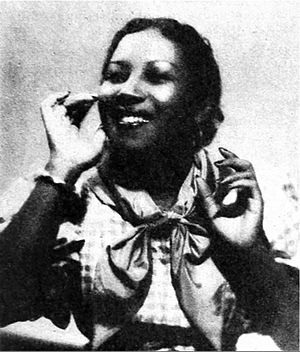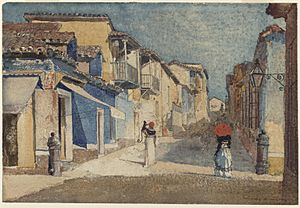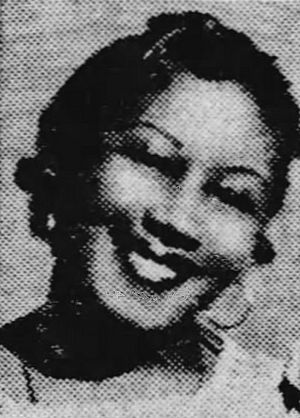Eusebia Cosme facts for kids
Quick facts for kids
Eusebia Cosme
|
|
|---|---|

1938 photograph from Cine-Mundial
|
|
| Born |
Eusebia Adriana Cosme Almanza
5 March 1908 Santiago de Cuba, Cuba
|
| Died | 11 July 1976 (aged 68) Miami, Florida, US
|
| Nationality | Cuban, naturalized American |
| Occupation | public speaker, actor |
| Years active | 1932–1973 |
Eusebia Cosme Almanza (born March 5, 1908 – died July 11, 1976) was a famous Afro-Cuban artist. She was known around the world as Eusebia Cosme. She became very popular in the 1930s for reciting poetry and acting.
Because of unfair rules about race, Eusebia couldn't easily become a theater actress in Cuba. Instead, she focused on declamation, which means reading poetry with great emotion. She was the only Cuban woman and one of the few black women to perform poems about African themes.
Her performances were more than just reading words. She used hand gestures, facial expressions, and changes in her voice. This helped her show the true feelings of the poems. She often chose poems that talked about important social issues. These included topics like race, gender, and the challenges faced by black people. Eusebia Cosme was truly a master of her art. She started her career in Cuba and later toured internationally.
In 1938, Eusebia moved to the United States. She became an American citizen in the 1940s. She performed to huge, sold-out crowds at famous places like Carnegie Hall. She also performed at The Town Hall and at universities for black students. She even performed with famous artists like Marian Anderson and Langston Hughes.
Eusebia introduced poems by African-American writers to Spanish-speaking audiences. She did this through The Eusebia Cosme Show on CBS Radio. This show aired from 1943 to 1945. She continued reciting poetry in the U.S. until the late 1950s. In the 1960s, she became an abstract painter. Then, in 1964, she started acting in movies and on TV.
From 1966 to 1973, Eusebia lived in Mexico City. She appeared in films like The Pawnbroker. Her most famous role was "Mamá Dolores." She played this character many times. She first played Mamá Dolores in a 1955 play in New York City. This character was from a radio show called El Derecho de nacer (The Right of Birth). Eusebia played her again in the 1966 movie and TV show of the same name. In 1971, she even starred in a spin-off film called Mamá Dolores. She won an award called the Premio Ónix for being the best actress in the 1966 film.
After having a stroke in Mexico City in 1973, Eusebia moved back to the United States. She spent her last years in Miami. Her belongings from Mexico were given to the Schomburg Center for Research in Black Culture. This center is part of the New York Public Library in Harlem. Her collection is now a valuable resource for people studying history. It helps them learn about Afro-Cubans and the wider African community.
Contents
Early Life and Education
Eusebia Adriana Cosme Almanza was born on March 5, 1908. Her birthplace was Santiago de Cuba, a city in Cuba. Her parents were Leocadia Almanza and Germán Cosme. Her father was a soldier in the Cuban War of Independence. This war helped Cuba gain freedom from Spain in 1898.
Eusebia's mother worked for a lawyer named Luis Fernández Marcané. He helped Eusebia get an education. From a young age, Eusebia loved stage performances. However, she noticed there were few non-white actors in plays. This made her think she couldn't be an actress. She worried she would only get small, stereotypical roles.
Eusebia enjoyed reading poetry. But she didn't always connect with the poems written by white authors. Then she discovered the poetry of Nicolás Guillén. His poems focused on African subjects and black culture. This was exactly what she was looking for!
Between 1926 and 1927, she studied music in Havana. She graduated from the Municipal Conservatory of Music. After school, she performed as a cupletista. This was a type of singing cabaret performance. In the late 1920s and early 1930s, she often appeared in variety shows.
Eusebia returned to Santiago and practiced her poetry reading skills. She performed for the Fernández Marcané family. Her first public performance in Santiago was in 1930. The family later moved back to Havana. In 1931, Eusebia began lessons in elocution. She studied at the Municipal Conservatory's Academy of Declamation. Her teacher was Graziella Garbalosa, the academy's director.
Garbalosa encouraged Eusebia to be unique. She told Eusebia to embrace her African roots. This helped her stand out from other performers. Eusebia used everyday language and created amazing routines. She used colorful backdrops, props, and fancy costumes. She would recreate scenes with big gestures to show the poem's feelings.
Her costumes matched the mood of her performances. For example, if she spoke about black mothers' struggles, she wore a traditional Cuban peasant dress. It had a kerchief on her head. For rhythmic, happy poems, she wore a rumba dancer's dress. This dress had a tight top and a ruffled skirt. Eusebia designed her own sets and chose the music. She was not just a performer; she was an artistic director.
Eusebia was trained in poseía negra. This is a special way of reciting poetry about the African experience. It often highlights the unfairness faced by black people after slavery. This style started in the Caribbean islands. It's often linked to Afro-Cuban poetry. The performances are deeply connected to the experiences of mixed-race people. They often had to navigate a white-dominated society. Most of these poetry reciters were men. Eusebia was one of the very few women.
Their performances followed the rhythms of danzón and rumba music. They also used traditional Spanish poetry styles. This art form was popular from the mid-1920s to mid-1930s. Since there were few women writers then, Eusebia recited poems by men. But her emotional performances made her an artist in her own right. She saw herself as a link between the poet and the audience. She brought the written words to life with feeling.
Cuban Career Highlights
When the Fernández Marcané family moved back to Santiago, Eusebia stayed in Havana. She lived with an aunt and taught students to pay her rent. In 1932, she performed poetry for a hurricane relief event. She shared the stage with musician Ignacio Piñeiro.
Her first big performance in Havana was on March 16, 1933. She recited a tribute to a Spanish actor at the Payret Theater. By this time, she had a set performance style. It had three parts, each with five or six poems. The poems were grouped by their social message and rhythm.
In 1934, she performed in Camagüey. Then she performed at the Lyceum, a women's club. That summer, she took part in an event by the Hispano-Cuban Institution of Culture. Fernando Ortiz, the president, praised her highly. He called her an artist who truly understood Cuban culture. He said she moved her audience to tears. In August, she performed at the Principal de la Comedia. Chic Magazine called her "the greatest artistic attraction" that month.
In 1935, she returned to the Principal de la Comedia. She recited poems by many writers, including Nicolás Guillén. A critic for El País said her art was unmatched. A magazine called Adelante described her as "black emotion, voice and rhythm."
By 1936, Eusebia was performing regularly and on radio shows. She started performing in more important venues. These included the Casino Español and the Teatro Martí. She also joined the Society for the Study of Afro-Cubans. She then traveled abroad for the first time. She performed in Puerto Rico, the Dominican Republic, and Haiti. She received mostly good reviews for her shows. People also praised her for sharing poems by Guillén and others.
As she grew as an artist, Eusebia added more poems to her shows. She included works from other poets of African descent. Her performances became more global. They featured poems by African-American, Afro-Puerto Rican, and Afro-Venezuelan poets. At the end of the year, she returned to Cuba. Her hometown of Santiago honored her. They gave her the title Hija Predilecta (Favorite Daughter).
Moving to the United States
In 1938, Eusebia left Cuba for a performance tour in Venezuela. This was part of a cultural mission for the Cuban Ministry of Education. She performed in Maracaibo and Caracas. In July, she went to Puerto Rico. She performed at the University of Puerto Rico. She gave 18 performances that month. She also visited areas known for their African traditions.
While in Puerto Rico, she decided to visit the United States. She sailed from San Juan to New York City. She arrived on August 22, 1938. Within a month, Eusebia was scheduled to perform at Carnegie Hall. On December 4, she performed to a sold-out crowd of over 3,200 people.
Her tour included performances at Howard and Yale. She also opened for Marian Anderson, a famous African-American singer. Eusebia's performances explored the experiences of Afro-Antilleans. She celebrated their culture and showed their struggles. She also used her poetry to make people think about race and gender. In the early 1940s, she married Rafael "Felo" Laviera. He was a white Puerto Rican mechanic from New York.
Eusebia appealed to many different audiences. Latin American publications called her Afro-Latina. American and European media saw her as an exotic, tropical artist. The African-American community saw her as a link to the wider African diaspora. Before coming to the U.S., most of her poems were by white Latino authors. In New York, she started focusing on black artists. She introduced works by writers like Paul Laurence Dunbar to Hispanic audiences.
Her place in the art world was special. She couldn't be compared to white actresses. They performed in different spaces. She also couldn't be compared to African-American actresses. Their cultural experiences were different. As a mixed-race Latina, Eusebia performed in big, international venues. These places were not open to "Negro" or African-American artists. Even though she performed in Spanish, the African-American community embraced her. Newspapers said that language was not a problem. They compared her performances to opera. Her gestures, expressions, and rhythm made words unnecessary.
In 1940, she performed at Northwestern University. Soon after, she went to Mexico City to perform at the Palacio de Bellas Artes. She performed in Morelia before returning to New York in January 1941. She wrote a song called Fue en el África (It Happened in Africa). RCA Victor recorded it later that year. She became a U.S. citizen in Laredo, Texas, in the early 1940s.
In 1942, she performed at Carnegie Hall again. The next year, she performed at The Town Hall. In 1943, she got her own radio show, The Eusebia Cosme Show. It aired on CBS and was broadcast across the Americas. She returned to Howard University in 1944 and 1946. She also performed at The Town Hall in 1945. There, she recited poems to honor Antonio Maceo Grajales's birthday.
In May 1946, Eusebia worked with Langston Hughes. They recited poetry by Nicolás Guillén. Eartha Kitt sang at the event. In 1947, she performed at the Club Cubano Inter-Americano in New York City. This was during the anniversary of the Grito de Baire.
In 1949, she worked with Hughes again. They performed a translation of Guillén's work called Cuba Libre. In 1952, she visited Cuba for the first time since 1938. She took her husband with her. She was celebrated in her hometown at the Universidad de Oriente. She received a national award. However, she was not allowed to be part of the official celebrations for José Martí.
She couldn't perform in Havana until May 1953. She was featured at the Pro-Arte Musical Auditorium. She then returned to New York. Her husband passed away there by the mid-1950s. In September 1955, she played "Mamá Dolores" in a play. It was based on the radio drama El Derecho de nacer (The Right of Birth). The play was at the Teatro Santurce in New York. In 1956, she performed at a poetry recital at The Town Hall. In 1958, she recited at Fairfield University. This marked the end of her main poetry career.
Painting and Film Career
Eusebia started painting abstract art. She showed her paintings at places like the Washington Square Outdoor Art Exhibit. This continued into the early 1960s. In 1964, she made her first movie appearance. She was in The Pawnbroker with Rod Steiger. The movie was directed by Sidney Lumet and released in 1965.
Eusebia moved to Mexico City in 1966. She lived at the Hotel Insurgentes. Her movie roles there were often simple. She played characters like housekeepers or older, motherly figures. She appeared in a movie version of El derecho de nacer. She played "Mamá Dolores" again. This film was directed by Tito Davison. She was named "best actress" of 1966 for this role. She received the Premio Ónix award. This award was a national sign of excellence in Mexico. Also in 1966, a TV company adapted the story for a telenovela. Eusebia played "Mamá Dolores" in this TV show too.
In 1968, Eusebia appeared in another TV show called Tres vidas distintas (Three Distinct Lives). The next year, she starred in Rosas blancas para mi hermana negra (White Roses for My Black Sister). In this movie, Eusebia's character dies in a car accident. Her heart is then donated to another character. In 1971, she worked in the TV show Cristo negro. She also appeared in the movie Vuelo 701 (Flight 701). This was a thriller about people who miss a doomed flight.
Davison directed a spin-off movie of El derecho de nacer in 1971. It was called Mamá Dolores, and Eusebia starred in the main role. Her last film was El derecho de los pobres (The Rights of the Poor). It was released in 1973. She was supposed to make another movie in May 1973. But Eusebia had a stroke and was cared for in Mexico City. A famous American actor paid for her nursing care. He also helped her move to Miami, Florida, in early 1974.
Later Life and Legacy
Eusebia Cosme passed away on July 11, 1976. She died at Jackson Memorial Hospital in Miami, Florida. She was buried in Flagler Memorial Park.
Eusebia Cosme's personal papers are kept at the Schomburg Center for Research in Black Culture. This center is part of the New York Public Library in Harlem. A writer named Eileen Charbo found her papers in Mexico. When Eusebia had her stroke in 1973, she left her belongings with a benevolent society. Charbo tried to get her costumes placed in the Smithsonian. When they weren't interested, she donated some clothes. Then she contacted the Schomburg Center about the rest of her items.
The archive has become a very important resource for scholars. It helps them study Afro-Caribbean identities. It also helps them understand how perceptions of the larger African community have changed. In 2013, a Cuban author published a book about Eusebia. It was called Eusebia Cosme, la rosa canela. In 2015, Eusebia was honored during Santiago de Cuba's 500th anniversary. An exhibit featured important citizens who shaped the city's culture.
Images for kids








